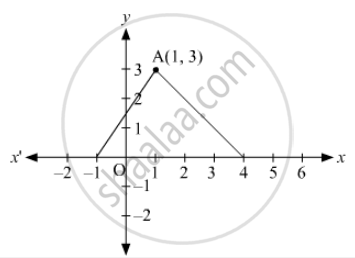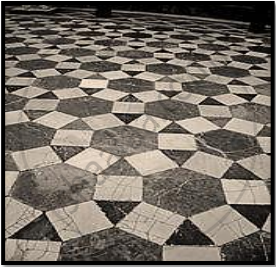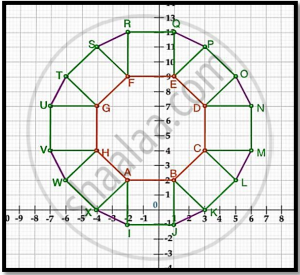Advertisements
Advertisements
Question
If (0, −3) and (0, 3) are the two vertices of an equilateral triangle, find the coordinates of its third vertex.
Solution
Let the given points be A(0, −3) and B(0, 3). Suppose the coordinates of the third vertex be C(x, y).
Now, ∆ABC is an equilateral triangle.
∴ AB = BC = CA
Squaring on both sides, we get \[36 = x^2 + \left( y - 3 \right)^2 = x^2 + \left( y + 3 \right)^2\]
\[x^2 + \left( y - 3 \right)^2 = x^2 + \left( y + 3 \right)^2 \]
\[ \Rightarrow y^2 - 6y + 9 = y^2 + 6y + 9\]
\[ \Rightarrow - 12y = 0\]
\[ \Rightarrow y = 0\]
Putting y = 0 in
\[x^2 + \left( 0 - 3 \right)^2 = 36\]
\[ \Rightarrow x^2 = 36 - 9 = 27\]
\[ \Rightarrow x = \pm \sqrt{27} = \pm 3\sqrt{3}\]
Thus, the coordinates of the third vertex are
APPEARS IN
RELATED QUESTIONS
Find the coordinates of the point where the diagonals of the parallelogram formed by joining the points (-2, -1), (1, 0), (4, 3) and(1, 2) meet
In what ratio is the line segment joining (-3, -1) and (-8, -9) divided at the point (-5, -21/5)?
Find the co-ordinates of the point equidistant from three given points A(5,3), B(5, -5) and C(1,- 5).
If (2, p) is the midpoint of the line segment joining the points A(6, -5) and B(-2,11) find the value of p.
Find the ratio which the line segment joining the pints A(3, -3) and B(-2,7) is divided by x -axis Also, find the point of division.
A point whose abscissa and ordinate are 2 and −5 respectively, lies in
A point whose abscissa is −3 and ordinate 2 lies in
If P ( 9a -2 , - b) divides the line segment joining A (3a + 1 , - 3 ) and B (8a, 5) in the ratio 3 : 1 , find the values of a and b .
If the points A(1, –2), B(2, 3) C(a, 2) and D(– 4, –3) form a parallelogram, find the value of a and height of the parallelogram taking AB as base.
Write the condition of collinearity of points (x1, y1), (x2, y2) and (x3, y3).
If the distance between the points (3, 0) and (0, y) is 5 units and y is positive. then what is the value of y?
If x is a positive integer such that the distance between points P (x, 2) and Q (3, −6) is 10 units, then x =
If (x , 2), (−3, −4) and (7, −5) are collinear, then x =
If the centroid of the triangle formed by the points (a, b), (b, c) and (c, a) is at the origin, then a3 + b3 + c3 =
If the centroid of the triangle formed by the points (3, −5), (−7, 4), (10, −k) is at the point (k −1), then k =
In Fig. 14.46, the area of ΔABC (in square units) is

Write the equations of the x-axis and y-axis.
If the perpendicular distance of a point P from the x-axis is 5 units and the foot of the perpendicular lies on the negative direction of x-axis, then the point P has ______.
Which of the points P(0, 3), Q(1, 0), R(0, –1), S(–5, 0), T(1, 2) do not lie on the x-axis?
A tiling or tessellation of a flat surface is the covering of a plane using one or more geometric shapes, called tiles, with no overlaps and no gaps. Historically, tessellations were used in ancient Rome and in Islamic art. You may find tessellation patterns on floors, walls, paintings etc. Shown below is a tiled floor in the archaeological Museum of Seville, made using squares, triangles and hexagons.

A craftsman thought of making a floor pattern after being inspired by the above design. To ensure accuracy in his work, he made the pattern on the Cartesian plane. He used regular octagons, squares and triangles for his floor tessellation pattern

Use the above figure to answer the questions that follow:
- What is the length of the line segment joining points B and F?
- The centre ‘Z’ of the figure will be the point of intersection of the diagonals of quadrilateral WXOP. Then what are the coordinates of Z?
- What are the coordinates of the point on y-axis equidistant from A and G?
OR
What is the area of Trapezium AFGH?
